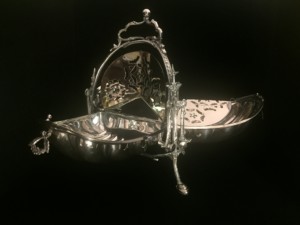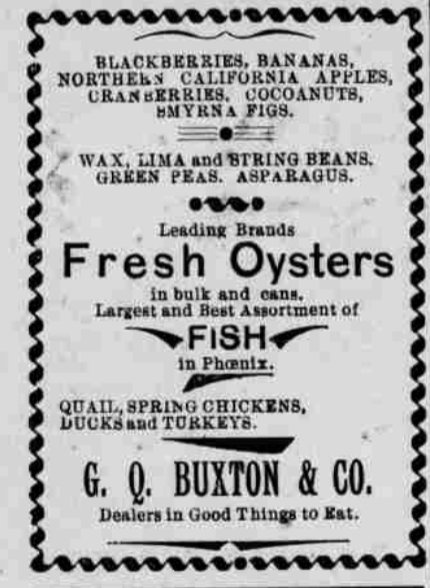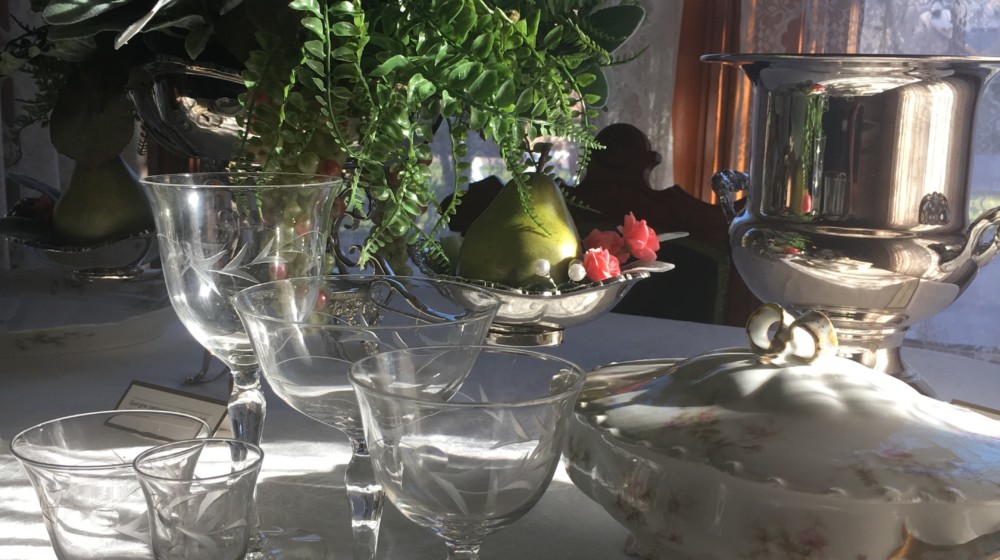Bon Appétit
 Did you know…
Did you know…
Our 2018 exhibit, Plate Expectations, gave us an excellent opportunity to root around in our cupboards and collection, to see what treasures we could find. Some, like the punch bowl owned by the Gammel family (who lived in the Rosson House from 1914 to 1948), are old favorites. Others, like this Victorian-style reproduction biscuit box (pictured right), were a definite surprise – eliciting such responses from our crew as, “I didn’t know we had that!”, to “What is that, anyway?”. (Hint – think of English biscuits/cookies, not Southern biscuits with gravy…) It was fun to see what we could come up with, and we’ve thoroughly enjoyed showing our visitors a brief look into Victorian dining.
 Two popular parts of the exhibit are the display of turn-of-the-century information and ads from local grocery stores, restaurants, oyster parlors (!!), and more; and on the opposite side of the room, the table set for a Victorian dinner, complete with lists of dining dos and don’ts. Visitors seem intrigued by the rules and regulations that governed table manners in fine houses like the Rosson’s, and have been somewhat astonished at the variety of food available to Phoenicians at that time (not to mention the difference in eating habits – yummmmmm, pickled tripe, lambs’ tongues and pigs’ feet!).
Two popular parts of the exhibit are the display of turn-of-the-century information and ads from local grocery stores, restaurants, oyster parlors (!!), and more; and on the opposite side of the room, the table set for a Victorian dinner, complete with lists of dining dos and don’ts. Visitors seem intrigued by the rules and regulations that governed table manners in fine houses like the Rosson’s, and have been somewhat astonished at the variety of food available to Phoenicians at that time (not to mention the difference in eating habits – yummmmmm, pickled tripe, lambs’ tongues and pigs’ feet!).
Etiquette books, such as The Ladies’ Book of Etiquette and Manual of Politeness by Florence Hartley (from which we gleaned our rules list), were all the rage to Victorians, particularly amongst the growing middle class. And, like self-help books today, each had their own ideas as to what constituted correct behavior (aside from the perennial Mom favorites – not talking with your mouth full, and keeping your elbows off the table, etc.). If you’re interested in reading any of these fantastic manners manuals, you can find many for free on Google Books, including the aforementioned book by Florence Hartley (1872); Etiquette, by Agnes H. Morton (1915); Sensible Etiquette of the Best Society, Customs, Manners, Morals, and Home Culture, by Clara Jessup Moore (1876); and Table Service, by Lucy Grace Allen (1920).
 There are a couple of good places online to find old Arizona newspapers, and in them, ads about restaurants, grocery stores, and just about everything else imaginable. The first is the Arizona Memory Project historic digital newspaper archive. The Project also has historic photographs, oral histories, maps, and many more. Another online archive of historic newspapers is The Library of Congress’s website, Chronicling America, where you can find digitized newspapers from all 50 states, some dating all the way back to 1789!
There are a couple of good places online to find old Arizona newspapers, and in them, ads about restaurants, grocery stores, and just about everything else imaginable. The first is the Arizona Memory Project historic digital newspaper archive. The Project also has historic photographs, oral histories, maps, and many more. Another online archive of historic newspapers is The Library of Congress’s website, Chronicling America, where you can find digitized newspapers from all 50 states, some dating all the way back to 1789!
Lastly, if you’re interested in what formal Victorian dinners were like, we highly recommend listening to The Feast podcast (we particularly love the special episode recorded live at Heritage Square earlier this year, the summer special about Arizona’s first cocktail, the one about Sonoran Foodways, and the Victorian meal in a dinosaur… No, really!). And, to actually see a Victorian dinner, you should watch Fannie’s Last Supper (included with Amazon Prime), and read the related book Fannie’s Last Supper: The Meal of the Century, by Chris Kimball of America’s Test Kitchen (2010). In it, a twelve-course meal from Fannie Farmer’s 1896 cookbook is recreated, using proper turn-of-the-century techniques, equipment and ingredients, not to mention the enormous wood burning stove that got so hot it started melting the polyester-blend clothing of some of the cooks! Our one bit of advice, though, is not to watch the part about the calf’s head while you’re eating. Otherwise, bon appétit!
Archive
-
2024
-
July (1)
-
June (1)
-
May (1)
-
April (1)
-
March (1)
-
February (1)
-
January (1)
-
-
2023
-
December (1)
-
November (1)
-
October (1)
-
September (1)
-
August (1)
-
July (1)
-
June (1)
-
May (1)
-
April (1)
-
March (1)
-
February (1)
-
January (1)
-
-
2022
-
December (1)
-
November (1)
-
October (1)
-
September (1)
-
August (1)
-
July (1)
-
June (1)
-
May (1)
-
April (1)
-
-
2021
-
December (1)
-
November (1)
-
October (1)
-
September (1)
-
August (1)
-
July (1)
-
June (1)
-
May (1)
-
April (1)
-
March (1)
-
February (1)
-
January (1)
-
-
2020
-
December (1)
-
November (1)
-
October (1)
-
September (1)
-
August (1)
-
July (1)
-
June (1)
-
May (1)
-
April (1)
-
March (1)
-
February (1)
-
January (1)
-
-
2019
-
December (1)
-
November (1)
-
October (1)
-
September (1)
-
August (1)
-
July (1)
-
June (1)
-
May (1)
-
April (1)
-
March (1)
-
February (1)
-
January (1)
-
-
2018
-
December (1)
-
November (1)
-
October (1)
-
September (1)
-
August (1)
-
July (1)
-
May (1)
-
April (1)
-
March (1)
-
February (1)
-
January (1)
-
-
2017
-
December (1)
-
November (1)
-
October (1)
-
September (1)
-
August (1)
-
July (1)
-
June (1)
-
May (1)
-
April (1)
-
March (1)
-
February (1)
-
January (1)
-
-
2016
-
December (1)
-
-
2015
-
2014
-
July (1)
-
